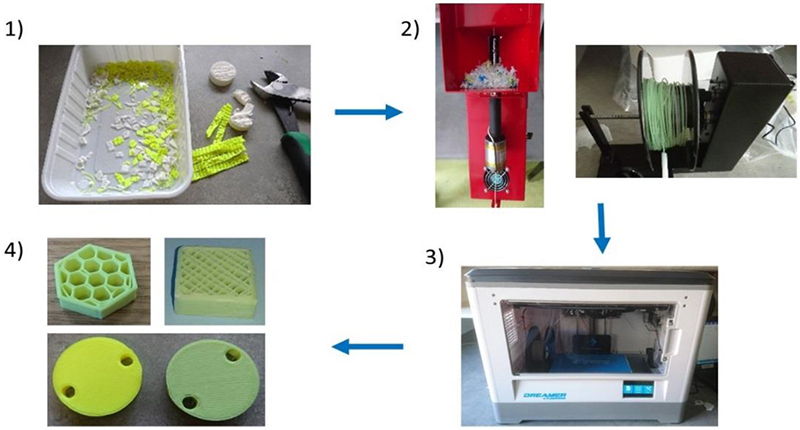A low carbon footprint approach to the reconstitution of plastics into 3D-printer filament for enhanced waste reduction
DOI:
https://doi.org/10.18502/keg.v2i2.621Abstract
In this study we aim to investigate recycling of waste plastics products into filaments for use in a typical FDM 3D printing system. We investigate the parameters relating to control of the filament thickness to a variety of different plastic types, which include HDPE and ABS. Following filament generation, parameters were investigated to optimise the print parameters to produce a variety of demonstration models, which test the print resolution. Results suggest that the proposed supply chain can allow for highly repeatable ABS and HDPE filament generation with a diameter of 1.74 ± 0.1mm and 1.65 ± 0.1mm respectively. Ultimately, the production of usable filaments can provide a viable means of consuming waste plastics and reducing the burden of increased landfill.
References
M. I. Mohammed, S. Haswell, and I. Gibson, Lab-on-a-chip or Chip-in-a-lab: Challenges of Commercialization Lost in Translation, Procedia Technology, 20, 54–59, (2015), 10.1016/j.protcy.2015.07.010.
S. M. Al-Salem, P. Lettieri, and J. Baeyens, Recycling and recovery routes of plastic solid waste (PSW): A review, Waste Management, 29, no. 10, 2625–2643, (2009), 10.1016/j.wasman.2009.06.004.
M. A. Kreiger, et al., Life cycle analysis of distributed recycling of post-consumer high density polyethylene for 3-D printing filament, Journal of Cleaner Production, 70, 90–96, (2014), 10.1016/j.jclepro.2014.02.009.
Plastic Recycling Fact Sheet. 2009; Available from: https://www.cleanup.org.au/PDF/au/cua_plastic_recycling_fact_sheet.pdf.
A. S. F. Santos, et al., Characterization of effluents through a typical plastic recycling process: An evaluation of cleaning performance and environmental pollution, Resources, Conservation and Recycling, 45, no. 2, 159–171, (2005), 10.1016/j.resconrec.2005.01.011.
M. Kreiger, and J. M. Pearce, Environmental Life Cycle Analysis of Distributed Three-Dimensional Printing and Conventional Manufacturing of Polymer Products, ACS Sustainable Chemistry & Engineering, 1, no. 12, 1511–1519, (2013), 10.1021/sc400093k.
I. Gibson, D. W. Rosen, and B. Stucker, Additive manufacturing technologies, vol. 238, Springer, (2010).
C. R. Rocha, et al., Novel ABS-based binary and ternary polymer blends for material extrusion 3D printing, Journal of Materials Research, 29, no. 17, 1859–1866, (2014), 10.1557/jmr.2014.158.
B. Christian, D. Matthew, and M. P. Joshua, Distributed recycling of waste polymer into RepRap feedstock, Rapid Prototyping Journal, 19, no. 2, 118–125, (2013), 10.1108/13552541311302978.


